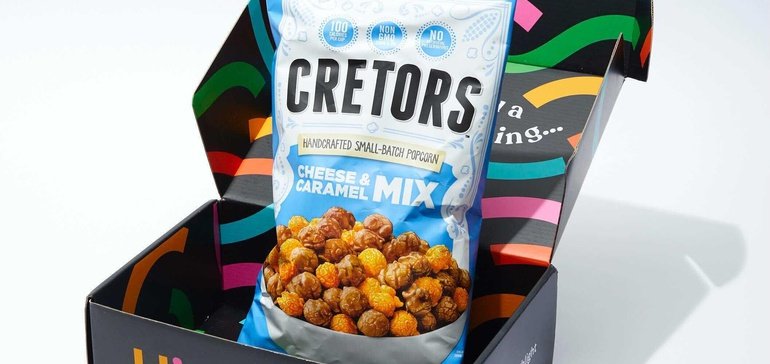CPGs think inside the subscription box for product testing

As Eagle Foods prepared to launch new flavors of its Cretors popcorn last year, executives at the Ohio-based company decided to test their indulgent offerings with consumers using an unorthodox way: a subscription box.
Before introducing its kettle corn drizzled in dark chocolate and farmhouse butter varieties, Eagle wanted to see how the products would resonate with popcorn lovers. But testing the product with consumers in a central location was too “clinical” and removed the real-world environment where they would typically eat it, while COVID-19 made it virtually impossible to connect with people at stores. Eagle literally had to think outside the box.
It partnered with Curion, a provider of consumer insights and product testing, to find 100 people who enjoyed popcorn. A third firm added full-size bags of the new Cretors varieties in still-unfinished packaging to subscription boxes, which also included products such as toothpaste, cereal, beverages, pilaf and a manicure kit, and mailed them to the consumers identified by Curion to try.
“We just saw this as a really, really great way to get a quick pulse and have people try the product in their homes in more of a natural setting,” said Kate Delagrange, manager of category and marketing insights at Eagle Foods.
Once participants received the popcorn, they were asked to try it like they normally would during the course of a week, either by themselves or with friends and family. Soon after, they went online to answer questions like: How was the texture of the popcorn? Was there too much chocolate? How was the ratio of sweet from the chocolate compared to the salty of the popcorn?
Curion then assessed the data, which could be seen in real time, to determine how well the product was meeting Eagle Foods’ objectives.
Delagrange said the company ended up not making any changes to its kettle corn drizzled in dark chocolate and farmhouse butter popcorn based on the feedback before it officially launched the products during the summer. But the subscription boxes provided “a really nice validation before the products go to market.”

Optional Caption
The “subscription economy” as a whole is forecast to increase to $1.5 trillion by 2025, more than double its level in 2020, according to UBS. This would make it one of the fastest-growing industries globally, the financial services firm said in March.
Subscription boxes are used for a diverse range of products from snacks and beverages to clothing, beauty supplies, arts and crafts and pet-related offerings.
Coca-Cola, for example, has an insiders club where consumers could pay to receive new or limited-edition products before they hit store shelves. Beam Suntory’s Jim Beam brand has a subscription service that sends users premium, limited-edition whiskeys and provides them with live tastings and access to member-only events.
The subscription box platform soared in popularity during the pandemic as consumers spent more time at home and looked to indulge and try new things, flocking online to sign up for the predictable delivery of their favorite products to their front door.
But using subscription boxes to actually test out products is a relatively untapped channel. Curion President Keren Novack said this application “could be a breakthrough in consumer product research” for CPGs.
“There’s tons of subscription boxes that are out there, so why shouldn’t there not be one where we focus specifically on customer research?” Novack said.
The novelty of using subscription boxes to test a product has been met with resistance by some food and beverage manufacturers concerned about relinquishing control over the testing or uncertainty over the other products being included along with their item when they are sent to consumers, Novak said. She added that companies risk missing out on a valuable opportunity to collect real-world information if they’re hesitant to try something new.
“We don’t experience products within a vacuum,” Novak said. She believes the subscription model for product testing is on trend with how today’s consumers try new products.
For its part, Delagrange said Eagle Foods would likely use subscription boxes again as a way to collect information quickly and to “check that we’re on the right path.”
The company may lean toward testing at a central location, she said, but in this instance, a subscription box “was just the right approach.”
Source: fooddive.com

